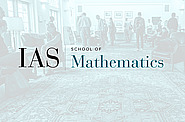Seminars Sorted by Series
Members' Colloquium
Nov
08
2021
Nov
15
2021
Members' Colloquium
Growth of cohomology in towers of manifolds: a topological application of the Langlands program
2:00pm|Simonyi Hall 101 and Remote Access
Nov
22
2021
Members' Colloquium
Mathematical foundations for human-level intelligence (Part 1): Cooperative communication as belief transport
2:00pm|Simonyi Hall 101 and Remote Access
Nov
29
2021
Members' Colloquium
Fluid equations: regularity and Kolmogorov’s turbulence theory
2:00pm|Simonyi Hall 101 and Remote Access
Dec
06
2021
Members' Colloquium
Old and New Results on the Spread of the Spectrum of a Graph
2:00pm|Simonyi Hall 101 and Remote Access
Dec
13
2021
Members' Colloquium
A new random model for the Euler and Navier-Stokes equations and related equations
2:00pm|Simonyi Hall 101 and Remote Access
Jan
17
2022
Jan
24
2022
Members' Colloquium
Cubic surfaces and non-Euclidean geometry
2:00pm|Simonyi Hall 101 and Remote Access
Jan
31
2022
Members' Colloquium
A mathematical approach to some problems in neurobiology
2:00pm|Simonyi Hall 101 and Remote Access
Feb
07
2022
Members' Colloquium
PDEs vs. Geometry: analytic characterizations of geometric properties of sets
2:00pm|Simonyi Hall 101 and Remote Access
Feb
14
2022
Feb
21
2022
Feb
28
2022
Members' Colloquium
A Gentle Approach to Crystalline Cohomology
2:00pm|Simonyi Hall 101 and Remote Access
Mar
07
2022
Members' Colloquium
The orbit method, microlocal analysis and applications to L-functions
2:00pm|Simonyi Hall 101 and Remote Access
Mar
21
2022
Members' Colloquium
On the unpredictability of fluid motions
2:00pm|Simonyi Hall 101 and Remote Access
Oct
10
2022
Members' Colloquium
Yamabe flow of asymptotically flat metrics
2:00pm|Simonyi Hall 101 and Remote Access - see Zoom link below
Oct
17
2022
Members' Colloquium
Noetherianity up to Symmetry
2:00pm|Simonyi Hall 101 and Remote Access - see Zoom link below
Oct
31
2022
Members' Colloquium
Polynomials Over $\mathbb{Z}$ and $\mathbb{Q}$: Counting and Freeness
2:00pm|Simonyi Hall 101 and Remote Access - see Zoom link below
Nov
14
2022
Members' Colloquium
Algebraic K-theory and the Cyclotomic Trace
2:00pm|Simonyi Hall 101 and Remote Access - see Zoom link below
Nov
21
2022
Members' Colloquium
Local Systems, Positivity and (Non-Commutative) Markov Numbers
2:00pm|Simonyi Hall 101 and Remote Access - see Zoom link below
Nov
28
2022
Members' Colloquium
An Introduction to Random Surfaces
2:00pm|Simonyi Hall 101 and Remote Access - see Zoom link below
Dec
05
2022
Members' Colloquium
The Other Galois Representation of an Elliptic Curve
2:00pm|Simonyi Hall 101 and Remote Access - see Zoom link below
Dec
12
2022
Members' Colloquium
Varieties of Markoff Type: Arithmetic, Combinatorics, Dynamics
2:00pm|Simonyi Hall 101 and Remote Access - see Zoom link below
Jan
30
2023
Members' Colloquium
Closing Lemmas in Contact Dynamics and Holomorphic Curves
2:00pm|Simonyi Hall 101 and Remote Access - see Zoom link below
Feb
06
2023
Members' Colloquium
Lefschetz Without Positivity: An Overview
2:00pm|Simonyi Hall 101 and Remote Access - see Zoom link below
Feb
13
2023
Members' Colloquium
Floer Theories and Reeb Dynamics for Contact Manifolds
2:00pm|Simonyi Hall 101 and Remote Access - see Zoom link below
Mar
06
2023
Members' Colloquium
Existence of Quasigeodesic Anosov Flows in Hyperbolic 3-Manifolds
2:00pm|Simonyi Hall 101 and Remote Access - see Zoom link below
Mar
13
2023
Members' Colloquium
Almost all Collatz Orbits Attain Almost Bounded Values
2:00pm|Simonyi Hall 101 and Remote Access - see Zoom link below
Mar
20
2023
Members' Colloquium
Recent Results on Finite Group Lattice Gauge Theories
2:00pm|Simonyi Hall 101 and Remote Access - see Zoom link below
Apr
03
2023
Members' Colloquium
Simple Zeros of Modular Form L-Functions
Alexandre de Faveri
2:00pm|Simonyi Hall 101 and Remote Access - see Zoom link below
Apr
10
2023
Members' Colloquium
Cohomology and arithmetic of some mapping spaces
2:00pm|Simonyi Hall 101 and Remote Access - see Zoom link below
Apr
17
2023
Members' Colloquium
Classification of Smooth Actions by Higher Rank Lattices in Critical Dimensions
2:00pm|Simonyi Hall 101 and Remote Access - see Zoom link below
Oct
16
2023
Members' Colloquium
Fourier Uniqueness and Nonuniqueness Pairs
Mikhail Sodin
2:00pm|Simonyi 101 and Remote Access
Oct
23
2023
Members' Colloquium
High Dimensional Variants of the Finite Field Kakeya Problem
2:00pm|Simonyi 101 and Remote Access
Nov
06
2023
Nov
20
2023
Members' Colloquium
Mass Generation By The Higgs Mechanism At All Couplings
Sourav Chatterjee
2:00pm|Simonyi 101 and Remote Access
Dec
04
2023
Members' Colloquium
Einstein, P-adic Sudoku, Domino, and Decidability
2:00pm|Simonyi 101 and Remote Access
Jan
29
2024
Members' Colloquium
Convergence of Unitary Representations and Spectral Gaps of Manifolds
2:00pm|Simonyi 101 and Remote Access
Feb
05
2024
Members' Colloquium
Dynamical Asymmetry Is $C^1$-Typical
Amie Wilkinson
2:00pm|Simonyi 101 and Remote Access
Feb
12
2024
Mar
18
2024
Members' Colloquium
Sum-of-Squares Proofs, Efficient Algorithms, and Applications
2:00pm|Simonyi 101 and Remote Access
Mar
25
2024
Members' Colloquium
Fourier Uniformity of Multiplicative Functions
2:00pm|Simonyi 101 and Remote Access
Apr
01
2024
